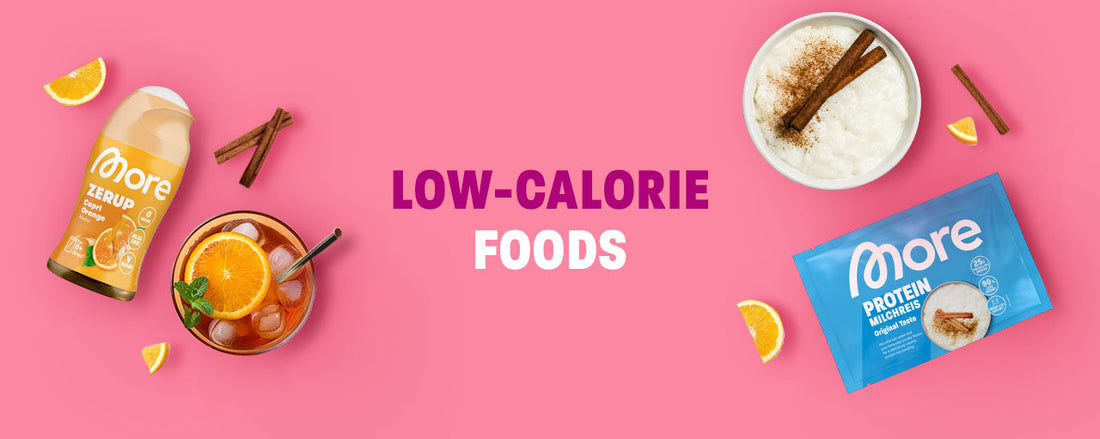
Caloriearme voedingsmiddelen: Top 20-lijst (inclusief dranken)
Gezondheid en voeding staan bovenaan ons lijstje met welzijnsdoelen. Maar hoe zorg je ervoor dat je heerlijke maaltijden klaarmaakt om af te vallen en tegelijkertijd calorieën bespaart? Het geheim schuilt in caloriearme producten die ook rijk zijn aan eiwitten . In deze uitgebreide blogpost leer je alles wat je moet weten over caloriearme producten, vezels en het belang van eiwitten voor je dieet . Je vindt er ook lijsten met heerlijke caloriearme producten die je in je dieet kunt opnemen.
Inhoud:
- Wanneer wordt een voedingsmiddel als caloriearm beschouwd?
- Lijst met caloriearme voedingsmiddelen - onze top 20 groenten, fruit en dranken
- Caloriearme groenten – onze top 8 lijst
- Caloriearm fruit – onze top 8 lijst
- Caloriearme dranken – onze top 4 lijst
- Voedingsmiddelen met veel eiwitten en weinig calorieën
- Caloriearme kant-en-klaarmaaltijden: bestaan ze? En zijn ze aan te raden?
- Caloriearme snoepjes en chocolade
- Zijn caloriearme voedingsmiddelen nuttig om af te vallen?
- Voelt u zich vol van caloriearme voeding?
- Conclusie
- Veelgestelde vragen
Wanneer wordt een voedingsmiddel als caloriearm beschouwd?
Voordat we dieper ingaan op de wereld van caloriearme voedingsmiddelen, is het belangrijk om te begrijpen vanaf welk punt een voedingsmiddel als "caloriearm" wordt beschouwd. In de meeste gevallen verwijst de term "caloriearm" naar voedingsmiddelen die minder dan 40 calorieën per 100 gram bevatten . Dit betekent dat ze een lagere energiewaarde hebben dan andere voedingsmiddelen.
Lijst met caloriearme voedingsmiddelen - onze top 20 groenten, fruit en dranken
Ben je op zoek naar eten met de minste calorieën? Hier zijn onze top 20 groenten, fruit en dranken.
Caloriearme groenten – onze top 8 lijst
-
Komkommers: Komkommers zijn een verfrissende groente met weinig calorieën, met slechts 16 kcal per 100 g.
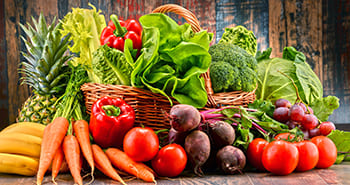
- Bloemkool: Deze groente bevat ongeveer 25 kcal per 100 g en is veelzijdig.
- Courgette: Courgette bevat ongeveer 17 kcal per 100 g en is zeer veelzijdig.
- Spinazie: Spinazie bevat ongeveer 23 kcal per 100 g en is rijk aan vezels en vitaminen.
- Broccoli: Broccoli bevat ongeveer 34 kcal per 100 g en is een goede bron van vezels en vitamines.
- Paprika's: Paprika's bevatten ongeveer 31 kcal per 100 g en zijn rijk aan vitamine C.
- Selderij: Selderij bevat ongeveer 16 kcal per 100 g en is een knapperige en caloriearme groente.
- Tomaten: Eén tomaat bevat ongeveer 18 kcal en is rijk aan vitamine C en antioxidanten.
Caloriearm fruit – onze top 8 lijst
-
Watermeloen : Met ongeveer 30 kcal per 100 g is watermeloen een verfrissende, caloriearme optie.
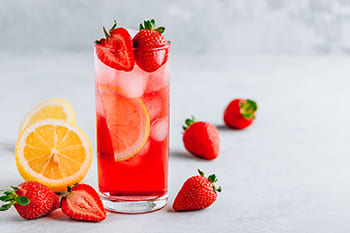
- Aardbeien : Aardbeien bevatten ongeveer 32 kcal per 100 g en zijn rijk aan vitamine C.
- Blauwe bessen : Deze kleine bessen bevatten ongeveer 32 kcal per 100 g en zijn een uitstekende bron van antioxidanten.
- Frambozen : Frambozen bevatten ongeveer 52 kcal per 100 g en zijn rijk aan vezels en vitamine C.
- Appels : Een middelgrote appel bevat ongeveer 52 kcal en is rijk aan vezels.
- Grapefruit : Een halve grapefruit bevat ongeveer 37 kcal en is een goede bron van vitamine C en vezels.
- Perziken : Eén perzik bevat ongeveer 39 calorieën en is een heerlijke, caloriearme vrucht.
- Kiwi : Eén kiwi bevat ongeveer 61 kcal en is rijk aan vitamine C en vezels.
Caloriearme dranken – onze top 4 lijst
-
Water : Geen calorieën en essentieel voor het lichaam.
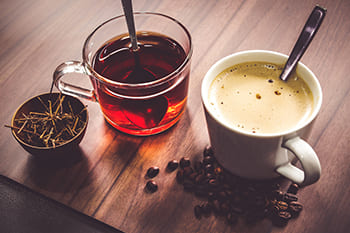
- Thee : Een drank met veel gezondheidsvoordelen en nauwelijks calorieën.
- Zwarte koffie : Zwarte koffie zonder suiker of melk bevat weinig calorieën en kan uw energie een boost geven.
- Water met caloriearme siroop : Een scheutje calorievrije siroop in water geeft een verfrissende smaak. Wij raden onze suikervrije drinksiroop aan in vele onvergelijkbaar lekkere, fruitige varianten – suikervrij en met bijna geen calorieën. De kleine knijpflesjes zijn handig voor onderweg en zeer zuinig – zo bereid je gemakkelijk een heerlijk en verfrissend drankje met weinig calorieën, altijd en overal.
Voedingsmiddelen met veel eiwitten en weinig calorieën
Nu we een overzicht hebben van caloriearme voedingsmiddelen, laten we ons richten op voedingsmiddelen die niet alleen weinig calorieën bevatten, maar ook veel eiwitten . Eiwitten zijn belangrijk voor het lichaam omdat ze helpen bij de opbouw van spieren en je langer een vol gevoel geven.
Veel eiwitten en weinig calorieën - voedingsmiddelen met deze eigenschappen zijn ideaal voor een evenwichtig dieet dat spieropbouw bevordert en tegelijkertijd de calorie-inname in de gaten houdt. Hier is een lijst met caloriearme voedingsmiddelen die ook rijk zijn aan eiwitten:
1. Kipfilet zonder vel : Mager gevogelte is een uitstekende bron van eiwitten.Caloriegehalte en eiwitgehalte per 100 g:
- Calorieën: ongeveer 165 kcal
- Eiwit: ongeveer 31 g
Caloriegehalte en eiwitgehalte per 100 g:
- Calorieën: ongeveer 135 kcal
- Eiwit: ongeveer 30 g
Caloriegehalte en eiwitgehalte per 100 g:
- Calorieën: ongeveer 143 kcal
- Eiwit: ongeveer 28 g
Caloriegehalte en eiwitgehalte per 100 g:
- Calorieën: ongeveer 82 kcal
- Eiwit: ongeveer 18 g
Caloriegehalte en eiwitgehalte per 100 g:
- Calorieën: ongeveer 143 kcal
- Eiwit: ongeveer 29 g
Caloriegehalte en eiwitgehalte per 100 g:
- Calorieën: ongeveer 144 kcal
- Eiwit: ongeveer 15 g
Caloriegehalte en eiwitgehalte per 100 g:
- Calorieën: ongeveer 193 kcal
- Eiwit: ongeveer 19 g
Caloriegehalte en eiwitgehalte per 100 g:
- Calorieën: ongeveer 370 kcal
- Eiwit: ongeveer 75 g
Caloriegehalte en eiwitgehalte per 100 g:
- Calorieën: ongeveer 72 kcal
- Eiwit: ongeveer 12 g
Caloriegehalte en eiwitgehalte per 100 g:
- Calorieën: ongeveer 59 kcal
- Eiwit: ongeveer 10 g
Caloriegehalte en eiwitgehalte per 100 g:
- Calorieën: ongeveer 35 kcal
- Eiwit: ongeveer 3 g
Caloriegehalte en eiwitgehalte per 100 g:
- Calorieën: ongeveer 52 kcal
- Eiwit: ongeveer 11 g
Caloriegehalte en eiwitgehalte per 100 g:
- Calorieën: ongeveer 116 kcal
- Eiwit: ongeveer 9 g
Caloriegehalte en eiwitgehalte per 100 g:
- Calorieën: ongeveer 164 kcal
- Eiwit: ongeveer 8 g
Caloriegehalte en eiwitgehalte per 100 g:
- Calorieën: ongeveer 20-30 kcal
- Eiwit: ongeveer 2-3 g
Caloriegehalte en eiwitgehalte per 100 g:
- Calorieën: ongeveer 120 kcal
- Eiwit: ongeveer 4 g
Caloriegehalte en eiwitgehalte per 100 g:
- Calorieën: ongeveer 120 kcal
- Eiwit: ongeveer 18 g
Caloriegehalte en eiwitgehalte per 100 g:
- Calorieën: ongeveer 135 kcal
- Eiwit: ongeveer 29 g
Caloriegehalte en eiwitgehalte per 100 g:
- Calorieën: ongeveer 110 kcal
- Eiwit: ongeveer 24 g
Caloriegehalte en eiwitgehalte per 100 g:
- Calorieën: ongeveer 71 kcal
- Eiwit: ongeveer 17 g
Deze voedingsmiddelen met veel eiwitten en weinig calorieën zijn perfect voor een eiwitrijk, caloriebewust dieet en kunnen de spieropbouw ondersteunen en je langer een vol gevoel geven . Je kunt de caloriearme voedingsmiddelen uit onze lijst, zoals kipfilet of zalm, ook combineren met andere eiwitrijke voedingsmiddelen . Probeer bijvoorbeeld eens onze heerlijke eiwitrijke noedels met meer eiwitten, meer vezels en minder koolhydraten. [$1] Of heb je zin in eiwitrijke wraps? Kies dan voor onze eiwitwraps met maar liefst 8 gram eiwit per wrap.
Caloriearme kant-en-klaarmaaltijden: bestaan ze? En zijn ze aan te raden?
Ja, er zijn caloriearme kant-en-klaarmaaltijden op de markt die speciaal zijn ontworpen voor mensen die hun calorie-inname willen verminderen of hun gewicht willen beheersen. Deze maaltijden zijn vaak verkrijgbaar als "dieetmaaltijden" of "kant-en-klaarmaaltijden voor gewichtsverlies". Ze kunnen een handige optie zijn als je weinig tijd hebt om te koken of op zoek bent naar een gemakkelijke manier om je calorie-inname onder controle te houden.
De volgende lijst toont u factoren voor het evalueren van caloriearme kant-en-klaarmaaltijden
- Ingrediëntenlijst : Lees de ingrediëntenlijst zorgvuldig. Goed bereide maaltijden moeten bestaan uit natuurlijke en gezonde ingrediënten, zonder overmatige hoeveelheden kunstmatige conserveermiddelen, additieven en geraffineerde suiker.
- Caloriegehalte : Het caloriegehalte zou inderdaad lager moeten zijn dan dat van conventionele kant-en-klaarmaaltijden. Controleer de voedingsinformatie om er zeker van te zijn dat u daadwerkelijk een caloriearme optie kiest.
- Portiegrootte : Let op de portiegrootte. Kant-en-klaarmaaltijden worden soms in kleine porties verpakt, waardoor je meer dan één portie kunt eten en dus meer calorieën binnenkrijgt dan je van plan was.
- Voedingswaarde : Zorg ervoor dat de kant-en-klaarmaaltijd nog steeds voldoende voedingsstoffen bevat, zoals eiwitten, vezels, vitaminen en mineralen. Een evenwichtige voedingswaarde is belangrijk om ervoor te zorgen dat je alle benodigde voedingsstoffen binnenkrijgt.
- Smaak en textuur : De smaak en textuur moeten je aanspreken. Als het bereide eten niet lekker smaakt of je het niet lekker vindt, zul je het waarschijnlijk niet regelmatig eten, wat niet goed is voor je dieet.
- Eigen voorkeuren : Houd rekening met je eigen voorkeuren en eetgewoonten. Sommige mensen bereiden hun maaltijden liever zelf, terwijl anderen het gemak van kant-en-klaarmaaltijden waarderen.
- Eetgewoonten op de lange termijn : Onthoud dat caloriearme kant-en-klaarmaaltijden mogelijk niet de oplossing voor een gezonde voeding op de lange termijn zijn. Het is raadzaam om gezonde kooktechnieken te leren en zelf maaltijden te bereiden om de controle over je dieet te behouden.
Over het algemeen kunnen caloriearme kant-en-klare maaltijden een nuttige aanvulling zijn op uw dieet, zolang ze hoogwaardige ingrediënten en een evenwichtige voedingswaarde bevatten. Ze zouden echter niet uw belangrijkste voedingsbron moeten zijn. Een evenwichtig en gevarieerd dieet met verse, onbewerkte producten is altijd de beste keuze voor uw gezondheid en welzijn op de lange termijn.
Caloriearme snoepjes en chocolade
Als je op zoek bent naar zoete en chocoladeachtige lekkernijen met weinig calorieën en waarbij je de hoeveelheid suiker kunt verminderen, zijn er een paar opties die je kunt overwegen. Deze snacks kunnen je zoetekauw bevredigen zonder al te veel calorieën te bevatten:
- Pure chocolade : Pure chocolade met een hoog cacaogehalte (70% of meer) bevat minder suiker en doorgaans minder calorieën dan melkchocolade. Pure chocolade wordt beschouwd als de chocolade met de minste calorieën en een stukje of twee kan al een heerlijke chocolade-ervaring opleveren.
- Met chocolade omhulde rijstwafels : Rijstwafels met een dun laagje pure chocolade zijn knapperig en zoet, maar bevatten minder calorieën dan zware chocoladerepen.
- Griekse yoghurt met honing en kaneel : Griekse yoghurt is rijk aan eiwitten en heeft een natuurlijke zoetheid. Een lepel honing en een snufje kaneel zorgen voor extra smaak.
- Fruitsorbet : Fruitsorbet is vetarm en bevat minder calorieën dan ijs. Er is keuze uit diverse fruitsmaken.
- Aardbeien met slagroom : Verse aardbeien met een vleugje slagroom kunnen een heerlijk dessert zijn dat niet al te veel calorieën bevat.
- Chiazaadpudding : Chiapudding kan gemaakt worden met magere melk of melkvervanger en is een gezonder alternatief voor traditionele pudding.
- Energieballetjes : Zelfgemaakte energieballetjes van havermout, noten en gedroogd fruit kunnen zoet en voedzaam zijn. Zorg ervoor dat je de hoeveelheid toegevoegde suiker beperkt.
- Gedroogd fruit : Gedroogd fruit zoals abrikozen, pruimen en rozijnen kan zoet en bevredigend zijn, zolang u er met mate van geniet. Het bevat namelijk geconcentreerde fruitsuikers.
- Mini Muffins : Zelfgemaakte mini muffins met magere melk en minder suiker zijn een chocoladeachtige optie die het aantal calorieën beperkt.
- Chocolade-eiwitrepen : Sommige eiwitrepen hebben een chocoladeachtige smaak en bevatten minder suiker en calorieën dan gewone snoepjes.
In een wereld waarin gezond eten steeds belangrijker wordt, is het verminderen van suiker een van de meest effectieve manieren om calorieën te besparen en tegelijkertijd een goede gezondheid te ondersteunen. Overmatige suikerconsumptie kan leiden tot diverse gezondheidsproblemen, waaronder obesitas, diabetes en hart- en vaatziekten. Producten zonder toegevoegde suiker zijn een uitstekende optie om de suikerconsumptie te verminderen en toch te genieten van lekkere zoete tussendoortjes.
Zijn caloriearme voedingsmiddelen nuttig om af te vallen?
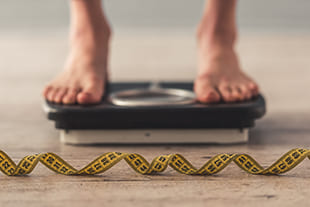
Ja, caloriearme voeding kan een nuttige aanvulling zijn op een gezond dieet als je gezond wilt afvallen . Het basisidee van afvallen is om meer calorieën te verbranden dan je via voeding binnenkrijgt , wat leidt tot een calorietekort. Caloriearme voeding stelt je in staat om grotere porties te eten zonder te veel calorieën binnen te krijgen en kan je dus helpen een calorietekort te bereiken.
Hier zijn enkele redenen waarom caloriearme producten nuttig kunnen zijn bij het afvallen:
- Gezonde verzadiging : Veel caloriearme voedingsmiddelen bevatten veel vezels, wat zorgt voor een langdurig vol gevoel. Dit betekent dat je je langer vol voelt en minder snel tussendoortjes neemt.
- Gezonde voedingsstoffen : Veel caloriearme voedingsmiddelen, met name groenten en fruit, zijn rijk aan belangrijke voedingsstoffen zoals vitaminen, mineralen en antioxidanten. Dit betekent dat je de voedingsstoffen binnenkrijgt die je nodig hebt zonder veel calorieën binnen te krijgen.
- Controleer uw calorie-inname : Met caloriearme voeding kunt u meer volume aan uw maaltijden toevoegen. Dit kan helpen om uw honger te verminderen en tegelijkertijd uw calorie-inname in de gaten te houden.
- Gezondheidsvoordelen : Het eten van caloriearme voeding, vooral groenten en fruit, wordt geassocieerd met een lager risico op hartziekten, diabetes type 2 en obesitas.
Het is echter belangrijk om te onthouden dat een uitgebalanceerd dieet nog steeds de sleutel is tot succesvol afvallen . Caloriearme voedingsmiddelen moeten deel uitmaken van een uitgebalanceerd dieet met voldoende eiwitten, gezonde vetten en koolhydraten.
Het is ook raadzaam om regelmatige lichaamsbeweging in uw dagelijkse routine op te nemen om gewichtsverlies te ondersteunen. Raadpleeg bij twijfel een voedingsdeskundige of arts om een voedingsstrategie op maat te ontwikkelen die uw gezondheid en welzijn bevordert.
Maar wees voorzichtig! Calorieën mogen niet het enige criterium zijn bij het kiezen van voedsel. Een uitgebalanceerd dieet met alle belangrijke voedingsstoffen, waaronder eiwitten, vezels en vitamines, is cruciaal voor je gezondheid.
Voelt u zich vol van caloriearme voeding?
Caloriearme voeding kan een vol gevoel geven, vooral als het veel vezels en water bevat. Vezels en water zijn twee belangrijke factoren die bijdragen aan verzadiging. Zo werkt het:
- Vezels : Vezels zijn de onverteerbare bestanddelen van voedsel die de maag opzwellen en een vol gevoel geven. Vezelrijke voedingsmiddelen kunnen je langer een vol gevoel geven omdat ze de maag vullen zonder veel calorieën te leveren. Voorbeelden van vezelrijke voedingsmiddelen zijn groenten, peulvruchten, volkoren granen en fruit.
- Water : Voedingsmiddelen met een hoog watergehalte, zoals fruit en groenten, zorgen er ook voor dat je je vol voelt. Het water in deze voedingsmiddelen vergroot de hoeveelheid voedsel die je eet en geeft je hersenen het signaal dat je genoeg hebt gegeten.
- Eiwitten : Eiwitrijke voedingsmiddelen, zoals mager vlees, vis, peulvruchten en zuivelproducten, kunnen ook vullend werken. Eiwitten stimuleren de aanmaak van verzadigingshormonen in het lichaam en kunnen helpen om honger te verminderen.
Het is belangrijk om te weten dat de combinatie van voedingsmiddelen in een maaltijd ook kan bijdragen aan een verzadigd gevoel. Een evenwichtige maaltijd met eiwitten, vezels en gezonde vetten kan je een vol gevoel geven en trek in eten voorkomen.
Het gaat echter niet alleen om de hoeveelheid calorieën, maar ook om de kwaliteit van het eten. Voedingsmiddelen met lege calorieën, rijk aan suiker en ongezonde vetten, bevatten misschien veel calorieën, maar zorgen er niet per se voor dat je je vol voelt en kunnen ertoe leiden dat je meer eet dan je eigenlijk nodig hebt.
Over het algemeen kunnen caloriearme voedingsmiddelen vullend zijn als ze veel vezels, water en/of eiwitten bevatten. Een uitgebalanceerd dieet met deze elementen kan je verzadigingsgevoel vergroten en je helpen je gewicht onder controle te houden.
Conclusie
Caloriearme voeding is een geweldige manier om je calorie-inname te verminderen zonder dat je het plezier van eten hoeft op te offeren. De hierboven genoemde voeding bevat vaak veel vezels en belangrijke voedingsstoffen, waardoor ze een gezonde keuze zijn . Het combineren van caloriearme voeding met eiwitrijke opties is vooral effectief als je probeert af te vallen. Ze helpen je om je vol en energiek te voelen terwijl je werkt aan je gezondheidsdoelen. Vergeet niet dat een evenwichtig dieet altijd essentieel is voor een gezonde levensstijl.
Veelgestelde vragen
[[Veelgestelde vragen]]
[ITEM-]
[Q-]Wat kun je eten met weinig calorieën? [-Q]
[A-]Er zijn veel caloriearme voedingsmiddelen, waaronder groenten, fruit, mager vlees, vis, peulvruchten en magere zuivelproducten.[-A]
[-ITEM]
[ITEM-]
[Q-]Welk soort brood bevat de minste calorieën?[-Q]
[A-]Volkorenbrood bevat over het algemeen minder calorieën dan witbrood en meer vezels.[-A]
[-ITEM]
[ITEM-]
[Q-]Welke voedingsmiddelen bevatten weinig calorieën en weinig koolhydraten?[-Q]
[A-]Groenten zoals broccoli, spinazie en bloemkool bevatten weinig calorieën en koolhydraten.[-A]
[-ITEM]
[[-Veelgestelde vragen]]
Bronnen:
[[BRON-]]Als ze gekookt zijn, bevatten ze gemiddeld 55% minder koolhydraten, 2 keer meer eiwitten en 4 keer meer vezels dan conventionele pasta van durumtarwegriesmeel.
Bevat uitsluitend van nature aanwezige suikers.[[-BRONNEN]]
![[shipping]](http://nl.morenutrition.com/cdn/shop/files/Truck_fb68f857-ef5e-4f72-8714-7f5bdb40a16a.png?v=1754667121&width=100)



